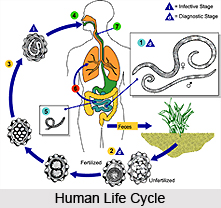 Samprapti is the name used for pathogenesis in the modern science. It is the observation of course of the disease. Samprapti provides the complete view of the disease. By following the tract of the disease the information about its advent and stages can be attained. Samprapti helps to judge the sequence of the disease and its pathogenesis.
Samprapti is the name used for pathogenesis in the modern science. It is the observation of course of the disease. Samprapti provides the complete view of the disease. By following the tract of the disease the information about its advent and stages can be attained. Samprapti helps to judge the sequence of the disease and its pathogenesis.
Samprapti is sequential distribution of pathogenesis that occurs in the body as a result of onset of the disease. It gives the details of the morbid processes that occurs in the different diseases or the stages of the same diseases i.e. vata, pitta, kapha, dhatus (seven dhatus), three malas(mutra, purish or swed) etc. The accumulation, movement and exacerbation of doshas and the process in which the disease takes place are included within sampraapti.
Samprapti is the understanding of the cause, effect, and the way it effects the constitution and the physiology of the body and finally resides in one part of the body. Sampraapti involves the main cause, precipitating factors, age, sex, time, pathology, diet and lifestyle and all other changes that is included within the sequence are known as sampraapti. Sampraapti is also called jaati and aagati.
An example can be set when doshas get aggravated due to a reason that enters into the amashya (stomach) and then cause inflammation (jatharaghni) and finally expels it out from its place of action i.e. amashya(stomach) and then it enters into the rasa dhatu to cause jwar(fever). Thus Sampraapti describes the morbid processes.
Sampraapti is subdivided into six categories-
Sankhaya or number- It is the number of varieties or types by which the diseases are manifestated. For an example, jwar (fever) can be eight types viz. vata, pitta, kapha, vatapitta, pittakapha, vatakapha, vatapittakapha and agantuj (external); kaas (cough)is of five types etc.
 Pradhanya or dominant-It is the predominance of a particular dosha or it confirms the causes of the disease is swatantra(primary or independent) or partantra (secondary or complication of primary disease).
Pradhanya or dominant-It is the predominance of a particular dosha or it confirms the causes of the disease is swatantra(primary or independent) or partantra (secondary or complication of primary disease).
Vidhi or Order- the disease cause is classified into two categories-nija (idiopathic or individual) or agantuja(traumatic). Or it can be classified into three categories i.e. saadhya (easily curable), aasadhya( incurable), krichsaadhya(difficult to cure) and yaapya(incurable disease but with judicious diet and conduct life can be prolonged).
Vikalpa-It is the measure in which the dosha is aggravated in the `doshic triad`(vata, pitta and kapha) or the measures in which the dosha or gunnas that excites the doshas that already exists.
Kala or Time- This is the time factor that makes the disease severe, moderate or mild . It may be seasons, day and night, hour of eating etc.
Bala or Strength-Bala is the strength of the disease that is determined by the severity of the attack, presence or absence of all the symptoms etc.
Sampraapti can be further divided into six stages by the action occurring inside the body. There are six stages by which a disease takes place. A physician must have the knowledge of all the six stages as it helps in getting the idea in which stage the disease can be cured. The disease can be checked in the first stage if the imbalance in dosha is reversed. If the dosha imbalance is not recognized and any prompt action is not taken, then the damage continues and the disease proceed to the next step. Similarly when each of the successive stages is neglected the disease takes a definite shape and may sometimes turn into yaapya(disease is incurable but judicious diet and conduct helps to prolong the life ) or aasadhya(incurable).
There are following six stages known as `shad kriya kaal` that are described in the doshic changes during the course of the disease.
Sanchaya or the accumulation phase-This is the accumulation of the aggravated or attenuated vata, pitta or kapha in their respective places instead of circulating in the body freely.
Prakopa or the excited phase-In this phase the altered dosha is excited and gets swollen.
 Prasara or spread- In this phase dosha spreads to various places of the body.
Sthanasanshraya or specific locations- The abnormal doshas are accumulated in other sites causing the diseases in the part affected and constitute the fourth kriya kaal. In this phase the clinical manifestation of the disease takes place and in this phase it presents itself as Purva roopam (prodromal symptoms).
Prasara or spread- In this phase dosha spreads to various places of the body.
Sthanasanshraya or specific locations- The abnormal doshas are accumulated in other sites causing the diseases in the part affected and constitute the fourth kriya kaal. In this phase the clinical manifestation of the disease takes place and in this phase it presents itself as Purva roopam (prodromal symptoms).
Vyakti or manifestation- This is the phase when all clinical features are completely manifested and represents the roopa (sign and symptoms) in the body.
Bheda or variation- It is the last stage of the shad kriya kaal where the disease takes place and might get chronic, or may be subsiding wholly or in extreme cases cause death. The result depends on the gravity of the condition and the treatment adopted.




















